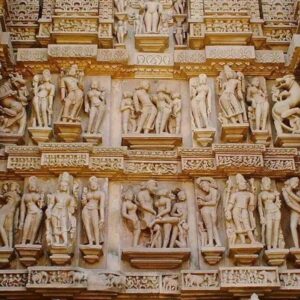- William Archer’s book “India and the Future,” published in 1917, sought to enlighten the Western world about Hindu religion and culture.
- Full of colonial hubris and little else, Archer made numerous misguided assertions about Hinduism, including claims of barbarism and lack of morality.
- While his book found popularity among the English aristocracy, possibly due to its confirmation bias and exoticism, it was roundly criticized by many prominent Indian scholars.
William Archer (1856-1924) was a Scottish writer, theater, and art critic and advocate for English spelling reform. He spent most of his career in London and made significant contributions to the literary and theatrical scene of his time. After studying at the University of Edinburgh, Archer became a leader-writer for the Edinburgh Evening News and later moved to London in pursuit of a legal career. However, he crash-landed in the world of art and theatre, and he became a renowned art and dramatic critic for publications such as The London Figaro and The World. Archer also had a secret passion – studying and critiquing[1] Hinduism.
William Archer, the self-appointed sage of Hinduism
With his Magnum Opus “India and the Future,” published[2] in 1917, Archer embarked on a noble mission to enlighten the Western world about the intricacies of Hindu religion and culture. Armed with a smattering of knowledge and a dash of Orientalist fantasy, Archer fearlessly delved into the depths of Hindu spirituality, dissected the caste system, art, and sculptures, and offered his profound insights on Indian manners and customs. Archer needed no accuracy and expertise, for he had the undying audacity to analyze an entire civilization. Archer’s absurd contribution to the vast pool of misguided Western interpretations of Hinduism added a touch of whimsy and amusement to an already absurd narrative created by comical attempts of Western Indologists at cultural exploration.
The book drew strong criticism from prominent Indian intellectuals of the time, notably Sri Aurobindo [3], who expressed their discontent with its contents.
India must be proved altogether barbarous in order to destroy or damage her case for self-government
William Archer was the gallant knight of misinterpretation. In his timeless work, “India and the Future,” he graced the world with his astute analysis of India’s alleged barbarism. One of the lines reads – India must be proved altogether barbarous in order to destroy or damage her case for self-government. A barbarous civilization lacks manners, language, culture, music, art, and even a governing system.
So, let’s examine the evidence. Sanskrit, the pinnacle of refinement in language, existed in India. Hindu culture, vibrant and diverse, permeated every aspect of life. The audacity to suggest that a civilization with treatises on music, such as the ancient Nātya Shastra, could be labeled barbarous! Written during the classical period of Indian history, this masterpiece contained 6000 shlokas and showcased the brilliance of Indian theatre, classical dance, and music. Of course, the esteemed Mr. Archer conveniently ignored the existence of such texts and the rich artistic traditions like Gond, Madhubani, Phad, and Chola Bronzes, among 500 other art forms.
And what about the governing system? Archer must have overlooked the great epics like the Ramayana and the Mahabharata, which deftly explored matters of state and governance. And let us not forget the Arthashastra, Kautilya’s magnum opus on statecraft and political strategy. These invaluable treasures were casually dismissed by the distinguished author, who apparently possessed an unparalleled ability to overlook inconvenient facts.
There is no real morality in Hinduism in terms of eudemonia, utilitarianism, or deontology
According to him, Hinduism lacks the essence of true morality, failing to embrace the lofty concepts of eudemonia, utilitarianism, and deontology.
Apparently, Archer had deemed himself the ultimate arbiter of happiness, pleasure, and the distinction between right and wrong. In his divine wisdom, he concluded that Hinduism is an unhappy religion, bereft of any moral compass.
But let’s take a moment to reflect on the grand tapestry of Hindu philosophy. From the Upanishads to the Bhagavad Gita, Hinduism offers profound insights into the nature of existence, the pursuit of truth, and the path to inner harmony. It embraces the concept of dharma, which encompasses moral duties and righteous actions, guiding individuals toward a virtuous life.
Eudemonia, the pursuit of happiness, finds its place within Hinduism through the notion of attaining spiritual liberation (moksha) and experiencing the bliss of union with the divine. The teachings of Hindu sages and seers emphasize the importance of inner joy, contentment, and serenity as the ultimate goal of human existence.
Utilitarianism, the doctrine of promoting happiness and pleasure, is intricately woven into Hindu ethics. The principle of ahimsa (non-violence) extends compassion towards all beings, promoting harmony and the well-being of the collective. Acts of kindness, charity, and selfless service are hailed as virtuous and noble, contributing to the overall welfare of society.
As for deontology, Hinduism upholds a moral framework based on dharma and the observance of righteous duties. The scriptures provide a comprehensive guide to discerning right from wrong, highlighting the importance of honesty, integrity, and ethical conduct in all aspects of life.
To dismiss Hinduism as an “unhappy” and “immoral” religion was a gross misrepresentation, indicative of a shallow understanding of its profound teachings. It was a testament to Archer’s limited perspective, where he failed to grasp the nuanced complexities and spiritual depth of one of the world’s oldest religions.
Indian art suffers from “Gargantuan Excess”
William Archer had a unique perspective on Indian art. According to him, the magnificent creations of ancient Indian sculptors, such as the idols of Ajanta and Ellora and the intricate erotic poses of Khajuraho, were nothing more than “gargantuan excess.”

Apparently, Archer, the esteemed art critic, was deeply troubled by the audacity of Indian artists in embracing their cultural expressions. The sheer beauty and intricate craftsmanship of these sculptures, which have captivated the world for centuries, were reduced to mere vulgarity in his eyes. Surely, Victorian morality suffered a bruise at the sight of such artistic wonders!
It is quite amusing that Archer, in his infinite wisdom, deemed it appropriate to dismiss the genius of Hindu sculptors, who are revered as some of the finest craftsmen in history. Their exquisite creations, with their attention to detail and spiritual symbolism, have stood the test of time and continue to inspire awe and admiration.
Archer’s limited understanding and cultural biases prevented him from appreciating the profound symbolism and artistic merit behind these sculptures. He failed to recognize the intricate dance between spirituality, sensuality, and aesthetics that permeate Indian art, thus reducing it to mere nudity and excess.
One can only wonder how such a man, who held the esteemed position of an art critic, could overlook the depth of artistic expression, the spiritual underpinnings, and the meticulous skill that went into creating these masterpieces.
Hindu music is of hopeless inferiority
In his delightful book, Archer graciously declared that Hindu music is of “hopeless inferiority.”
One must marvel at Archer’s remarkable ability to dismiss the vast and diverse world of Hindu music in a single sweeping statement. From the ancient ragas that evoke deep emotions to the soul-stirring devotional chants and the intricate rhythms of classical compositions, Hindu music has a rich and profound heritage that has captivated audiences for centuries.
One wonders if Archer had ever had the pleasure of listening to the mesmerizing strains of the sitar, the melodies of the bansuri, or the enchanting rhythms of the tabla.
Sitting cross-legged and contemplating one’s own navel
William Archer dismissed Pranayama as “Sitting cross-legged and contemplating one’s own navel.”
William Archer, with his keen powers of deduction and profound insights into the mysteries of the world, dismissed the profound practice of Pranayama, the ancient art of breath control and spiritual elevation, as a mere act of sitting cross-legged and fixating on one’s own navel.
Little did he know that Pranayama is a profound discipline that goes far beyond the physical act of sitting. It is a gateway to inner harmony, a practice that allows one to tap into the very essence of life force and harness its transformative power. He must be turning in his grave as the West embraces “mindfulness,” which is plagiarised Pranayama in its true essence.
Rama is too saintly for Human Nature
William Archer, the master of hasty conclusions and superficial observations, deduced that Rama (Shri Ram) possessed virtues that were beyond the reach of ordinary mortals. But did he bother to delve deeper into the complexities of Rama’s character?
Yes, Rama was undoubtedly a noble figure, revered for his righteousness and unwavering devotion. However, on the battlefield, he displayed a ferocity and prowess that made even the fiercest warriors tremble. Yet, Mr. Archer conveniently chose to overlook these aspects, preferring to pigeonhole Rama as an unattainable saintly figure.
And the irony! By acknowledging Rama’s exceptional greatness, Mr. Archer inadvertently admitted that Rama stood head and shoulders above any figure in his own religious traditions. Perhaps he couldn’t bear to face the fact that a Hindu hero could surpass the standards set by his own cultural icons.
Sita, the type of conjugal fidelity and chastity, is so excessive in her virtue as to verge on immorality
Archer, the great judge of women’s virtue and morality, asserted that Sita’s unwavering fidelity and chastity border on immorality. So if a woman is devoted to her husband and stops the evil advances of other men, she borders on immorality? But that’s the ideal woman. Archer’s thick brain was inept in understanding the seemingly simple aspect of Devi Sita’s character. Devi Sita was a reflection of an ideal Hindu woman.
The Popularity of his book
Archer’s book found a willing audience among the English aristocracy. How intriguing it is that a work steeped in confirmation bias could garner such acclaim. It seems that even in the realms of literature, the echoes of prejudice find a receptive audience.
One cannot help but wonder if it was the extensive detailing that captivated the readers or, rather, the reassurance of their preconceived notions. Confirmation bias, after all, has a way of resonating with those who seek validation for their existing beliefs, even at the expense of objective analysis.
In the corridors of the English elite, where exoticism and Orientalism were in vogue, Mr. Archer’s work found its place. The intricate descriptions of a distant land and its people offered a tantalizing glimpse into the world of the “other,” reinforcing the superiority and self-assuredness of the English aristocracy.
In Conclusion
William Archer was the master of recycling. He effortlessly assembled a patchwork of borrowed opinions and presented them as his original creations. How charmingly unoriginal! His book is a marvelous display of laziness and self-assuredness, relying on second-hand ideas and superficial impressions. Archer’s journalistic trickery knew no bounds as he dismissed an entire culture and reduced it to base vulgarity.







